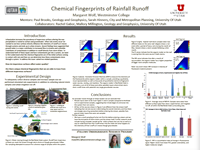iUTAH Team - Undergraduate iFellows
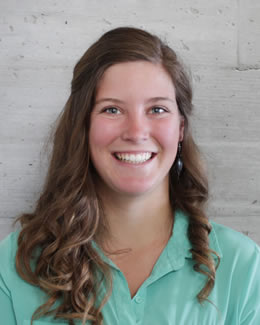
Margaret Wolf
Westminster College
Mentors:
Faculty: Sarah Hinners, UU
Faculty: Paul Brooks, UU
Graduate:
Research Focus:
Research Focus Area 2
Major:
Environmental Science
Geology - Minor
Biography:
Margaret Wolf is an environmental science major and geology minor at Westminster College going into her senior year. Originally from Spokane, Washington, Margaret grew up ski racing all over the west coast and fell in love with Salt Lake City; it’s snow, and all of its outdoor opportunities that it has to offer. She is excited about being apart of the iFellows program and is looking forward to learning more about the Wasatch watershed and how we work with water in Utah.
iFellow Presentation
Weekly Recap:
Week 1 | Week 2 | Week 3 | Week 4 | Week 5 | Week 6 | Week 7 | Week 8 | Week 9 | Week 10 | Week 11
Week 1: May 18-22, 2015
This week I learned how to use the SmartChem, chemical analysis machine, located at the Earth Science and Engineering lab at the University of Utah. The machine is essentially a spectrophotometer that can help us measure nitrates and other elements from both stream and soil samples collected around The Red Butte Creek and surrounding runoff areas. The first week was great!
Week 2: May 25-29, 2015
This week I got a better idea of how the Red Butte Watershed works and was able to go out with a team and collect our bi-weekly samples at all of the stream sights. The picture below is of our two filter pumps that we run to obtain the samples to then be sent to the lab for analysis. Our research team also ordered all of the supplies to build portable storm water sampling kits that we will begin to distribute among researchers at all levels to collect run off samples from different locations within the Red Butte Creek watershed.
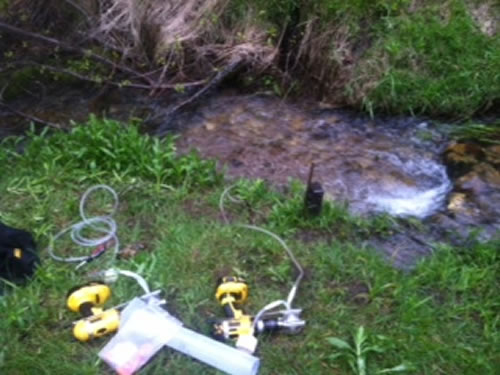
Filter pumps at Red Butte
Week 3: June 1-5, 2015
This week I have been developing my own project. I have come up with a few different research questions that I want to explore mostly concerning rainwater runoff. I have developed a research plan to "stimulate rain events" and basically be able to see how the chemistry of rain water changes as it runs over different surfaces like parking lots, grassy areas or native ecosystems. I am doing this in addition to collecting storm water samples whenever there is a rain event, but this is a way to experimentally construct a rain event without having to wait for the weather. I am excited to almost be complete with the panning process and begin to actually run experiments. This week I was also able to visit the Red Butte Creek reservoir dam and see how the Utah Water Conservancy regulated the flows for the reservoir and the fish within it.
Week 4: June 8-12, 2015
This week I helped develop a procedure to stimulate a rainfall. I am trying to find out the chemical changes of rainwater runoff when it encounters different surfaces. The photos below show an example of us stimulating a "rainfall event" to catch runoff from two different roofing surfaces. We hope to see what chemical fingerprint each different roof surface has and eventually if those chemical signatures end up in Red Butte creek. This week I was able to develop research methods and take both roof samples as well as storm samples from real rain.
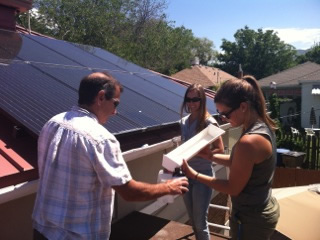
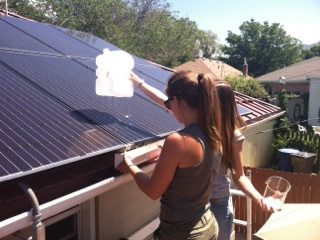
Making it rain with Dr. Paul Brooks and Master's student Mallory Millington
Week 5: June 15-19, 2015
This week I was able to collect and filter multiple storm samples from the thunderstorm on Monday night. We are hoping to be able to have a wide variety of sample sights throughout the valley including run off from roofs, roads and parking areas. We were also able to continue sampling later in the week with the stimulated rainfall events. We also had an iFellows cohort session this week where we learned about the essentials of presentations and what to include.
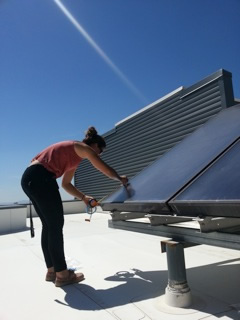
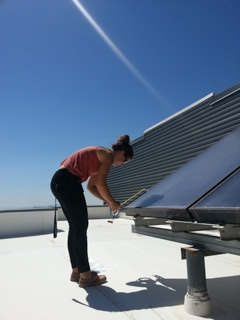
On the roof of the Geology Building at the University of Utah creating a fake rain event over a solar panel roof surface
Week 6: June 22-26, 2015
This last week I was able to complete my poster presentation. I also organized and prepped multiple samples to be able to run our Smart Chem machine this upcoming week to start getting real data on all of the samples collected so far.
Week 7: June 29-July 3, 2015
This week I was able to collect more samples for my storm water experiments. We added a new category that includes irrigation run off and we were able to collect samples from over watering sprinklers around the University of Utah surrounding neighborhoods. This week we also began to run the samples that I have collected so far. I am learning about the process of fluorescence and using a fluorometer to test the samples for the chemistry of their dissolved organic materials (DOM). WE also ran them through the SMARTCHEM to test for nitrate levels in the samples as well. It's been a great week.
Week 8: July 6-10, 2015
This week I was able to make connections between the samples that have been taken and the data we have been able to process so far. I was able to collect absorbance data, N-NO3 data, and total dissolved organic carbon data. This data has allowed me to begin to compare the beginnings of the chemical fingerprints of different surface types and how those surfaces affect rainwater run off. Along with our storm samples, experimental rain samples, we have begun to collect runoff from irrigation around the University of Utah.
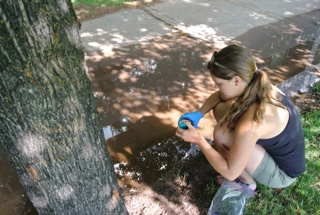

Collecting irrigation runoff
Week 9: July 13-17, 2015
This past week I was able to complete data analysis on all of my storm samples. I also completed my poster and presented at the iUTAH symposium on Friday. On Thursday we went to all of the Red Butte Creek sites to flag their locations in order to prep for the all hands sampling that is happening in the up coming week. Things are wrapping up and going really well.
Week 10: July 20-24, 2015
I started out the week helping with the All Hand Sampling effort in Red Butte Creek. On Monday I led a team of volunteers to teach them how to properly filter and split stream samples taken from urban sites in Salt Lake City neighborhoods. On Tuesday instead of gong with the stream chemistry team I joined the soil sampling team and leaned how to take soil samples p to 1M depth with an auger. These samples were going to be tested for isotopes to determine the ground water levels around the stream banks, this was all in the upper reaches of Red Butte Canyon. On Wednesday a team of us went door to door in an area known to have lots of ground water seeps in their back yards. Pictured below is a koi pond diverted from a ground water seep. We were able to talk to a lot of neighbors on Sunnyside Ave about their experiences dealing with a constant shift of seeps and springs and how they have dealt with them.
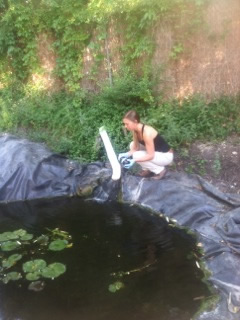
Mallory sampling the inflow to a Koi pond, directly from a groundwater seep

Ridley and Mallory taking a ground water sample
Week 11: July 27-31, 2015
The past few weeks have been pretty crazy compiling data for our final presentations and then presenting to a board of our peers and mentors. My overall results told me a lot about how storm water and surfaces impact Red Butte Creek and how groundwater is one of the most important contributors to Red Butte Creek's flow rate. I have now completed all 11 weeks of the iUTAH program and overall it was an incredible learning experience and a great opportunity to be introduced into the world of research.

